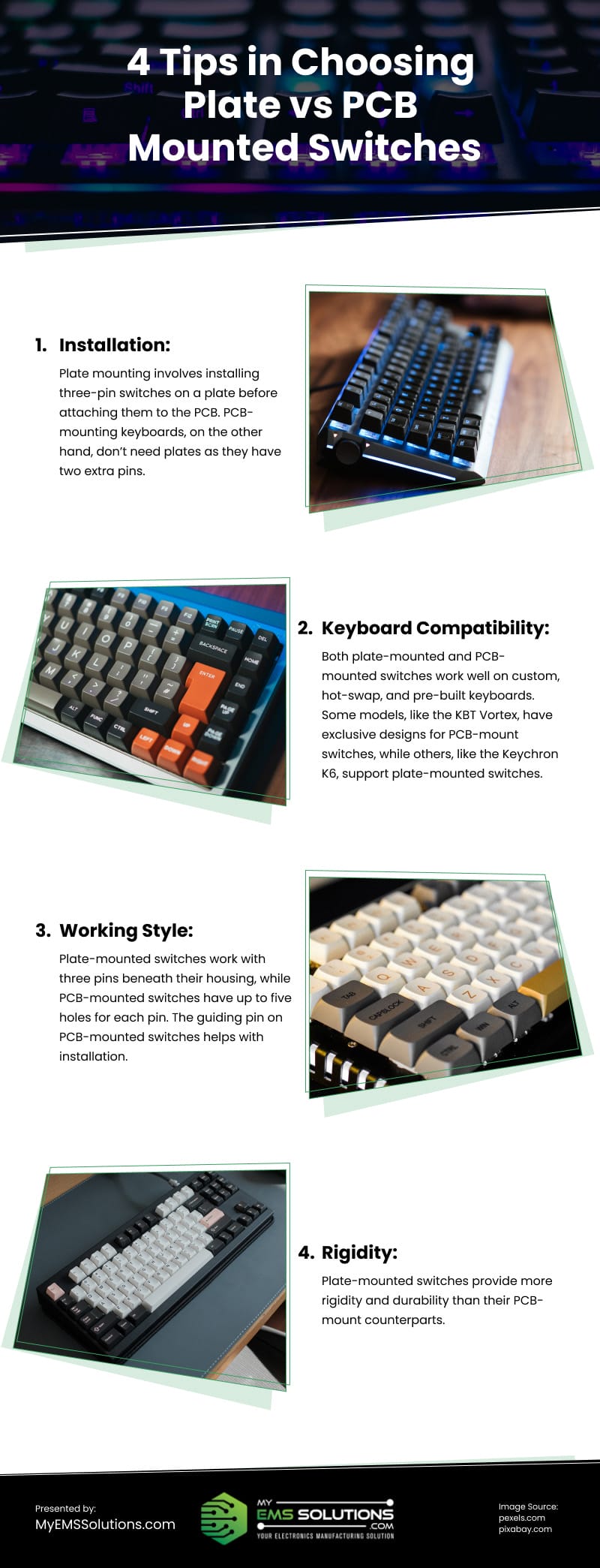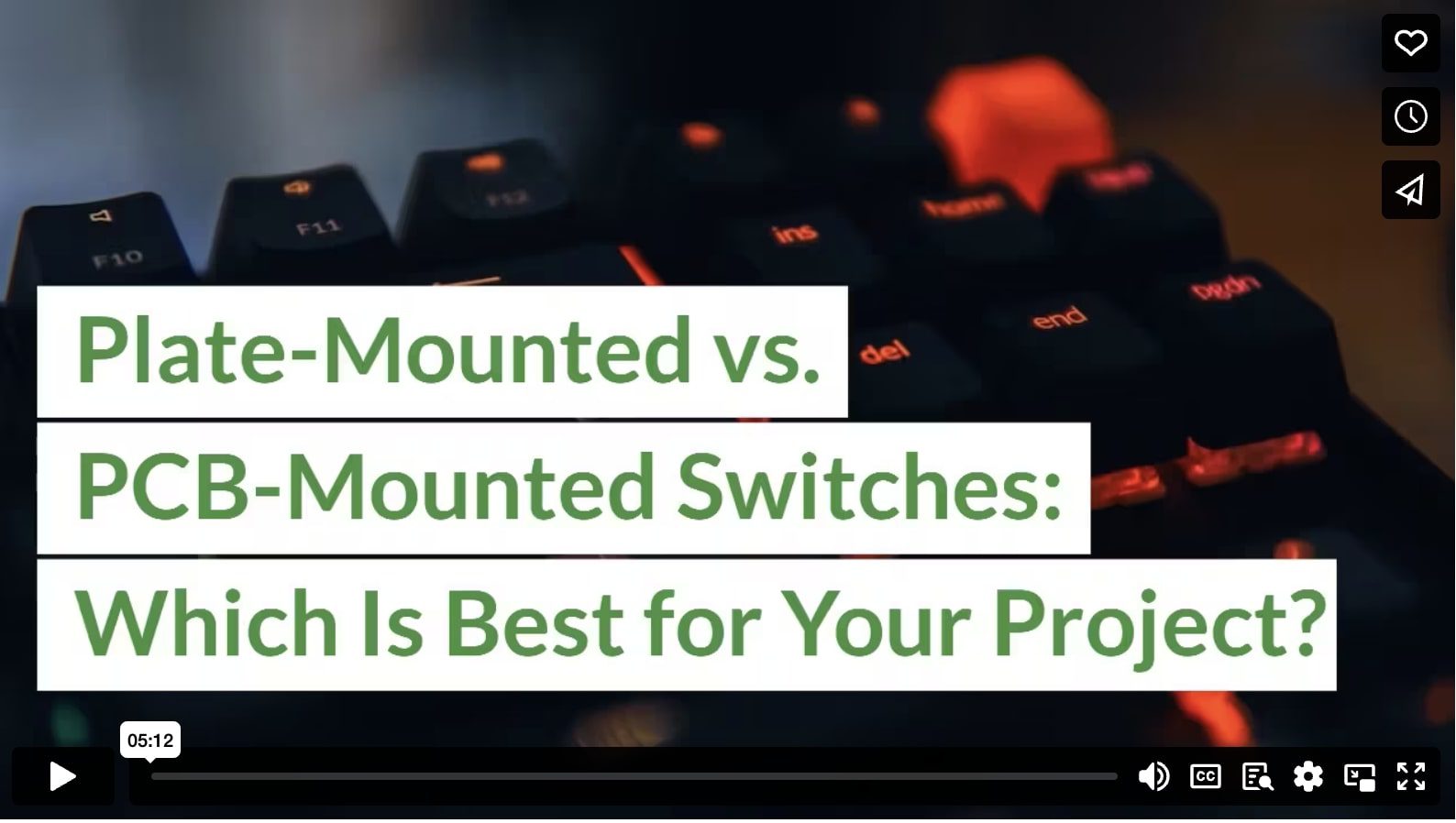Looking for the perfect keyboard switch? Make sure to consider the mounting style before you make a purchase. This is what determines whether your chosen switches will work with your keyboard or not.
You can choose from two options – plate-mounted (3-pin) switches and PCB-mounted (5-pin) switches. Understanding the differences between these two is crucial if you want to make an informed decision. In this article, we’re going to dive deep into the details of each, so you can choose the right one for your project.

(wayhomestudio/Freepik)
What are plate-mounted switches?
Plate-mounted switches are switches designed to be mounted on a plate before installation on a PCB. This provides additional support for the keys and can help reduce side-by-side key wobbling during use.
If you choose to use plate-mounted switches, you’ll enjoy the high-quality performance, stability, and the prevention of flexing. Plus, converting PCB-mounted switches to plate-mounted ones is a straightforward procedure that requires cutting the switch pins and securing them to the metal plate. This makes it a great choice for larger keyboards where plate-mounting is preferable.
But since plate-mounted switches have three pins, they are incompatible with direct circuit board mounting. Therefore, we don’t recommend using them for plate-less builds.
Pros:
- High-quality performance
- Improved stability and flexing minimization
- Non-complicated conversion procedure for PCB-mounted switches
Cons:
- Compatibility issues with direct circuit board mounting
- The mounting plate becomes very hard to move once the process is finished
What are PCB-mounted switches?
PCB-mounted switches are the way to go if you’re after a stable and wobble-free keyboard design. Compared to the plate-mounted varieties, PCB-mounted switches feature two extra pins for extra stability.
The central pin and two plastic side pins coordinate with the metal pins to ensure a secure connection between the switch and the printed circuit board assembly.
Pros:
- Secure and stable keyboard design that is perfect for small keyboards
- The 5-pin structure provides extra stability, reducing flex and wobble
- Easily modifiable and affordable switches
- More options for modifications and customizations
Cons:
- Can be challenging to repair
- Are less compatible than plate-mounted switches
Plate-mounted and PCB-mounted switches: How do they differ?
Switches for mechanical keyboards are either plate-mounted or PCB-mounted. Each mounting method has its advantages and disadvantages, so let’s take a closer look at both.
- Installation: Plate mounting involves installing three-pin switches on a plate before attaching them to the PCB. PCB-mounting keyboards, on the other hand, don’t need plates as they have two extra pins.
- Keyboard Compatibility: Both plate-mounted and PCB-mounted switches work well on custom, hot-swap, and pre-built keyboards. Some models, like the KBT Vortex, have exclusive designs for PCB-mount switches, while others, like the Keychron K6, support plate-mounted switches.
- Working Style: Plate-mounted switches work with three pins beneath their housing, while PCB-mounted switches have up to five holes for each pin. The guiding pin on PCB-mounted switches helps with the installation.
- Rigidity: Plate-mounted switches provide more rigidity and durability than their PCB-mount counterparts.
Converting 5-pin switches into 3-pin ones
The additional number of legs is the only difference between 5-pin and 3-pin switches. This means you must clip out the additional pins to convert a five-pin switch into a three-pin one. Though it sounds simple to do, it requires focus to remove the correct pins and prevent damage to the keyboard.
Use a nail clipper or another sharp object to remove the two plastic side pins. And do not clip the metal ones because they help the switch send keystroke signals to the PC. Likewise, leave the central fat pin alone — these pins are essential for the switches to function properly.
Using plate-mount switches with 5-pin hot swap PCBs
It’s possible to use plate-mount switches with 5-pin hot swap switches. But the two extra holes would prevent them from offering superior sturdiness. Also, the unstable alignment of the PCBs will result in decreased typing quality.
However, there’s no way to convert a 3-pin switch into a 5-pin one. So, when doing your project, you may want to use a 5-pin switch as it offers extra stability, and you can easily convert it into a 3-pin switch when required.
Is your keyboard using three- or five-pin switches? Determining this requires you to take a look at its pins. A five-pin keyboard contains a central pin, two plastic pins, and two metal ones. Meanwhile, a three-pin keyboard features two metal pins and a central pin. Understanding the number and type of pins on your keyboard switches is crucial in choosing the right replacement parts and troubleshooting any issues that may arise.
Choosing between plate-mount and PCB-mount switches can be a head-scratcher. Plate-mount switches are easier to access and cheaper, while PCB-mount switches are sturdier due to their extra pins. But the difference is negligible. If you’re wondering which to get, it depends on your keyboard compatibility. For versatility, it’s recommended to choose the 5-pin PCB-mount version.
You can also discuss your needs with an experienced PCB assembly provider. They can provide valuable insights into the pros and cons of each type of switch and help you make an informed decision. Additionally, they can offer guidance on other aspects of PCB assembly, such as component selection and layout design, to ensure that your keyboard is built to the highest quality standards.
Infographic
Are you trying to find the best keyboard switch? The mounting style is a crucial consideration before making a purchase because it determines compatibility with your keyboard. Plate-mounted (3-pin) switches and PCB-mounted (5-pin) switches are the two options available. Comprehending the differences between these two possibilities in detail is essential to arriving at an informed conclusion. We will go into the details of each in this post so you can choose the best one for your project.

Video

